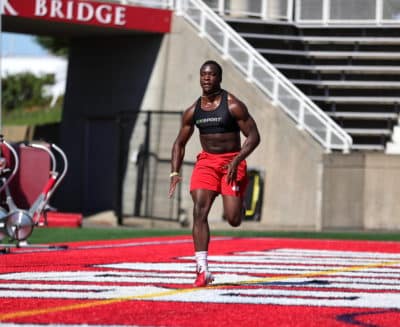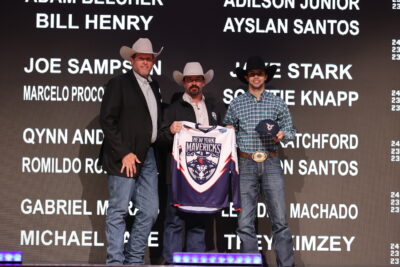
Fall sports were postponed at many college universities across the country until at least the spring due to the COVID-19 pandemic.
Among the schools impacted were Hofstra University and Stony Brook University.
However, both schools are starting to prepare for games as if they will happen in the spring.
Social distanced workouts are their method of preparation in the interim, with Hofstra University set to start those up later this month.
“We got the go ahead to start practicing,” Pride women’s soccer player and defender, Krista Agostinello, said. “I think in mid-September we are set to begin. It will obviously be very different, but we’re pretty much flipping our season. The things that we would normally be doing in spring, we are now doing in the fall. Hopefully, we’ll end up having that full fall schedule in the spring.
“We get to start lifting and work with our strength-and-conditioning coaches. The only thing about it is that we have to do it in a 10 x 10 square. So, with whatever we are doing, all of the equipment will be given to us, whether it’s weights, bands, etc. It could be outside or inside. You’re doing the work by yourself and, initially, we can only start out with about 10 people per session. Whether it’s a lift or anything with a strength-and-conditioning coach, you can only have 10 people. It’s a 15 minute warm-up and then a 30-45 minute workout for the day.”
Then, we’ll probably start to begin working in small groups of five-to-10 people. It still won’t be with any contact, but it will be different from running by yourself for sure.”
Stony Brook University’s football team, meanwhile, began similar workouts in August.
Both sports could require significant amounts of contact, especially football, which raises questions about how either could return to the field in the near future.
“I had previously thought they were going to cancel the season before they announced it given that I couldn’t see a way in which you could have 100 players from each team plus stuff and coming in contact with each other,” Seawolves wide receiver Peter McKenzie said. “With spit and sweat all around, I didn’t see how it could be safe. Unless if they come up with permanent solutions for this, I don’t feel like football would be smart without it being 100% safe.”
His teammate and wide receiver, John Corpac, believes it would be unsafe to bring back football if conditions are the same as right now, but hopes that won’t be the case come the spring.
“I’m worried, but given that the sport is postponed until the spring, the numbers will, hopefully, be down by then,” Corpac said. “For now, though, I think it’s definitely good that we aren’t playing because I don’t really see how we could’ve played games for a sport like football.”
While contact sports are going to be harder to bring back than those that are non-contact, Michael J. Alaia, MD of NYU Langone Orthopedic Center believes that it certainly is possible to have a safe return.
“Obviously, sports in which players do not come into close contact such as golf and tennis are the safest for return, Alaia said. “The more dangerous ones would be large team sports with frequent close contact, such as football or hockey. However, as we know, the NHL and NBA have done a tremendous job in terms of minimizing risk and there has been several weeks lately with thousands of tests and no positive results, particularly for the NHL.
“We can certainly alter training grounds and facilities to make sure athletes are keeping some semblance of distance. Other modifications can be made, such as having teams compete against fewer teams or shortening seasons, or spending more time doing individualized or paired drills during practice.”
Another concern that could arise is in relation to players previously impacted by COVID-19. There isn’t data about the long-term effects of having COVID-19 are, meaning playing sports could be dangerous for some players.
“We know from many of these leagues that players that have had symptomatic coronavirus are now playing symptom-free and without significant complications,” Alaia said. “There are some hypotheses that players may be at increased risk of certain complications, although to my knowledge, none of these have been proven clinically. Athletes who have recovered from the virus should undergo a proper screening to ensure normal pulmonary and cardiac function.”
Returning to sports will be a unique challenge in multiple facets, though, with one of those being the ability to coach a team normally.
“Most of our players haven’t played a game since last fall,” Pride women’s soccer coach, Simon Riddiough, said. “The demands on the body are extreme, no amount of running or weight training can emulate the physical requirements of the game. Also, since everything has been virtual, we have no real way to gauge how each individual player has applied themselves.
“We will have to get the players to be physically fit and ready to compete while providing a safe and injury-free environment and motivate them mentally to stay the course. We can’t rush back into something which will increase the likelihood of an injury and we need to keep them mentally positive about the unique situation they’re placed in.”
While there will certainly be some added challenges for coaches this season, there could be some benefits to coaching in these conditions.
“Everything is focused on you as a player since there aren’t many players and we’re working in small groups,” McKenzie said. “Coaches can concentrate on you a lot more individually.”
Whether or not players choose to opt-out of the spring season, each fall sport student-athlete has been granted an extra year of eligibility with the spring season not counting towards that.
For players who choose to participate in both the spring season and the fall season of 2021, that would mean double the amount of games played in a year.
“I feel like the turnaround is very quick, but it will be a special case for players who want to do that,” McKenzie said. “Players know how their bodies are and once the season is over, you only get a month or two to start working yourself right back into shape. I think that’ll be hard, but I think that depends on how the spring season goes for each player. For instance, if he’s a very good player who wants to go to the NFL, he definitely wouldn’t be able to. However, if he feels like he wants to just continue his college football career, he should definitely take advantage of the fall.”
Regardless of the conditions that are necessary for a return to sports, just getting to play again will be cherished by many student-athletes.
“Playing sports is really what we all look forward to,” Agostinello said. “We complain sometimes that it’s hot outside or that we have to do too much running, but anyone would gladly deal with that to be back at it. We’d listen to any type of guidelines. We can’t even step on our field until mid-September and it’s awful to not be able to even workout on our own field. Anything that could help us get back there would make us feel better right now. We won’t take it for granted anymore.”



















